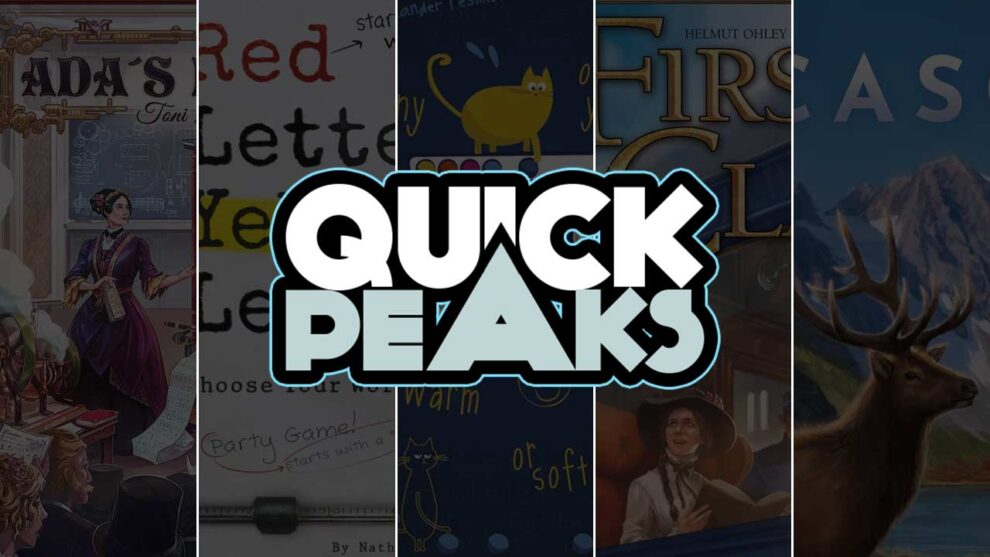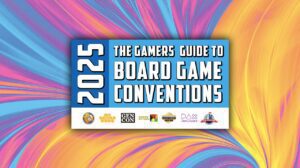Ada’s Dream – Bob Pazehoski, Jr.
As a fan of all things Ada Lovelace, I backed Ada’s Dream without reading the rules. I knew I wanted to be a part of the project. Without a doubt, Ada’s Dream is the most ambitious game I’ve attempted in a long time. I studied the rulebook for hours in order to get my teach down to 30 minutes. Our foursome sat for four hours with this title. Yes, you read that correctly. Four hours for the first play. Still, I love it.
The central mechanism of Ada’s Dream is a rondel of dice which players collect in order to build a model of the Analytical Engine, the 19th century prototype of a computer. The game’s expected 18 turns are split between gathering those dice and installing them in the Engine, or the Mill as it’s called in the game. Based on their color, installed dice unleash one of the game’s four major Action sequences. Each sequence has a unique protocol with a corresponding bonus track (and bonus actions). As the game wears on, Action sequences grow in length and strength, unleashing combinations as if it were a roll and write. Choices and protocols and combinations extend and complicate the learning curve for this title. They also contribute to an interesting game narrative—visiting Ada’s study for ideas, building relationships with prominent patrons, sitting in on lectures at various institutions, and traveling about to gather support. The end result is a 3×3 calculator, rows and columns of simple calculations with corresponding programs—built in the hopes of winning Ada’s approval.
The first attempt at Ada’s Dream is played passing the well-organized rulebook from hand to hand. The player aids are spectacular, the iconography is sensible. But there are rules galore and icons abounding. I have a feeling the second play would be 30% shorter, and perhaps shorter yet with greater familiarity. I also have a feeling that the game’s 90-120 minute estimate is an eternal understatement. In my circles, I’m not sure I’ll be able to table this one with any frequency (especially if I have to teach it every time), but I’ll be eager to do so when a friend is interested. In the meantime, my wife and I will continue our exploration as we have time. I find Ada’s story compelling, and I’m glad to grant this game entrance into my fascination.
Ease of entry?:
★★☆☆☆ – Not an easy onboard
Would I play it again?:
★★★★★ – Will definitely play it again
Read more articles from Bob Pazehoski, Jr.
Red Letter, Yellow Letter – Kevin Brantley
I’m always on the hunt for new party games that break the mold. Too often, party games are clones of Cards Against Humanity or Codenames. The ones I enjoy most tend to be word or spelling games that require quick-witted thinking.
Red Letter, Yellow Letter comes to us from 25th Century Games, and the rules are so simple they’re printed right on the front of the box. Flip a “thing” card and name something that doesn’t contain the red letter but starts with the yellow letter. The fastest player collects one of the three cards, revealing a new round, and the first player to collect three of each card type wins.
Many rounds were straightforward—like naming fruit that starts with a “B” but doesn’t contain an “H.” Other rounds had the group straining, like trying to name a soup that starts with “G” but doesn’t contain an “A” (hint: gumbo).
It’s easy to break out at family functions thanks to its simplicity, but the game never really hits a “fun” mark. Because the letter placements are static (starts with and doesn’t contain), players can easily queue up rapid-fire responses in their heads for categories as soon as the cards flip. It can leave a “feels bad” feeling for players who may not be as fast.
More often than not, we ended up playing through the deck as a brain exercise rather than an actual game. I feel it would benefit from more variety in the letter conditions, like requiring a specific number of letters or a sequence (similar to Things in Rings).
It’s fine—very okay—but the draw of simplicity will appeal to non-gamers who want to test their spelling mettle. Just don’t expect this to stand out in the sea of word and letter games.
Ease of entry?:
★★★★★ – No sweat
Would I play it again?:
★☆☆☆☆ – Would play again but will cry about it
Read more articles from Kevin Brantley.
Perfect Mismatch – Justin Bell
Perfect Mismatch is a word association party game from the team at Ares Games…yes, the same Ares Games known for its excellent, highly competitive wargame and 4X-adjacent content such as the Quartermaster General series, the War of the Ring games, and the Mega Civilization reprint Mega Empires. In this way, the irony of the title Perfect Mismatch is too great to ignore.
Up to eight players race to score the most points by trying to guess which of the active round’s five potential answers is the right choice. The active player, who is randomly assigned a word from a clue card in the center of the table (imagine the clue cards used in the superior Just One), must work with a clue board that has five scales showing two extremes. For example, let’s say the active player’s word is “sand.” On a weighted scale, how would you describe sand: closer to “chill” or “cooperative”? “Creative” or “flying”? “Environmental” or “rustling”? Using a set of six pink tokens on each scale, the active player has to move these voting tokens towards one side of the scale or the other.
All other players watch the active player sort this out, and when they think they know what word the active player is going for, they slap their guess on a scoreboard that grants more points for guessing the earliest. In our experience, guesses are all over the map because the clue words and the attribute words are also all over the map. Scores were that way, too; one player was so far ahead after just four turns that it rendered the fifth and final round moot, so Perfect Mismatch also has the potential to have a runaway leader problem. Players often took the easy way out by splitting the six voting tokens and moving three towards each end of the scale. Perfect Mismatch borrows a couple of its ideas from other game mechanics that I think work better elsewhere. While I appreciate that Ares took a swing at a category outside their wheelhouse, the results had us thinking that these were resources better spent on another wargaming property instead.
Ease of entry?
★★★★★ – No sweat
Would I play it again?
★☆☆☆☆ – Would play again but will cry about it
Read more articles from Justin Bell.
First Class: All Aboard the Orient Express! – Andy Matthews
In First Class: All Aboard the Orient Express, players act as both conductor and engineer of the fabled Orient Express. Over the course of the game you draft cards which increase the length of your train, allow your conductor to move forward through the cars, and allow the train itself to traverse through your route.
Mechanically speaking the game is quite easy. On your turn you pick a card from one of three rows of 6 (no matter the player count). That card might be an action (which triggers one of the previously mentioned actions), or it might be a specialty card from one of the various modules selected at the beginning of the game. As cards are picked, not only do choices narrow slowly, but once a number of cards equal to the player count have been selected from a single row, the remainder of the row is discarded. This is brutal because it means you have to really focus on what you want and hope that your opponents don’t want something from the same row.
The downside of this as a first time player is that the rulebook was pretty rough, and my opponent and I had questions nearly the entire game. Because of this, the setup took about half as long as the game itself. So much so that if we had started earlier in the night I would have suggested we play again immediately. But once we got a few rounds in, it really started humming and we both came away pleased with the results. First Class: All Aboard the Orient Express is out of print, but if you can find a copy, it’s definitely worth your time.
Ease of entry?
★★☆☆☆ – Not an easy onboard
Would I play it again?
★★★★★ – Will definitely play it again
Read more articles from Andy Matthews
Cascadia – K. David Ladage
I have seen many reviews of Cascadia, most singing its praises. I am not sure what has kept me from trying the game, but it has just never been one that has hit a game table near me. I recently went to visit a friend and he pulled out Cascadia and suggested we play. This is a delightful game!
We played the Family variant, since three of the players had never played before. It was a fun and interesting puzzle. When the gamer was over, my friend showed me the scoring cards that are used when you want to play the game without the family-mode-training-wheels.
Oh my! Some of the ways you have to get these animals to appear on your board gave me a headache just thinking about them. But… they also made me wonder at the possibilities. On our way home, I asked my wife what she thought and she told me she loved it. I had a great time as well, so this is now a game (with expansions) that is now on our list to acquire.
Ease of entry?
★★★★☆ – The odd bump or two
Would I play it again?
★★★★★ – Will definitely play it again
Read more articles from K. David Ladage.













